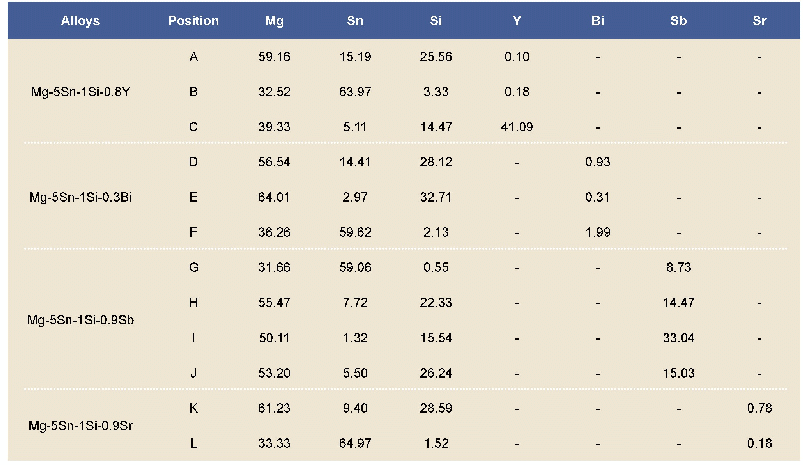《Table 1:Nominal compositions of experimental Mg-5Sn-1Si alloys (wt.%)》
 提示:宽带有限、当前游客访问压缩模式
提示:宽带有限、当前游客访问压缩模式
本系列图表出处文件名:随高清版一同展现
《"Microstructures and tensile properties of as-cast Mg-5Sn-1Si magnesium alloy modified with trace elements of Y, Bi, Sb and Sr"》
The nominal compositions of Mg-5Sn-1Si based alloys used in this study are presented in Table 1.The investigated materials were prepared with a resistance furnace by melting pure Mg(>99.90%),Sn(>99.99%),Bi (>99.99%),Sb (>99.99%)and master alloys of Mg-5.0%Si,Mg-10%Sr and Mg-30.0%Y in a steel crucible.Before melting,all of the raw materials were preheated to 120°C to remove the surface moisture.The pure Mg ingots were firstly put into the steel crucible and heated to 720°C with protection of mixture gas of 0.5vol.%SF6 and99.5vol.%CO2.When the pure Mg ingots were completely melted,the preheated Sn,Bi,Sb,Mg-30.0%Y,Mg-10%Sr and Mg-5.0%Si master alloys were respectively added into the Mg melt.Then the temperature was raised to 780°C and held for30 min to ensure the Mg-5.0%Si master alloy being completely melted.During holding period,the melts were stirred with a carbon bar for several times in order to melt the Mg-5.0%Si master alloy completely and make the compositions of the melts uniform.Then,the melts were cast into ingots with a diameter of 105 mm and a length of 450 mm.In order to analyze the microstructures of the alloys,the as-cast metallographic samples were prepared in accordance with the standard routines and etched with picric acid solution(5 g picric acid+10 mL glacial acetic+10 mL distilled water+80 mL anhydrous ethanol)for 5-10 s at room temperature.Microstructural analysis was conducted by using an optical microscope (OM,Olympus GX51)and a scanning electron microscope(SEM,JSM-6700F)equipped with an energy dispersive X-ray spectrometer(Oxford,Germany).The phases of the alloys were analyzed by using X-Ray diffraction(XRD,Rigaku D/max-3C type,Japan),the radiation source was Cu Kα,scanning step and range were 0.033°and 10°-90°,respectively.Thermal analysis by differential scanning calorimetry (DSC)were performed using a NETZSCH STA 2500 system.For the DSC tests,samples weighed around 20 mg were heated under flowing argon atmosphere from room temperature to 750°C.The heating curves were recorded at a controlling speed of 5°C·min-1.The tensile properties at room temperature were determined from the stress-strain curves.The 0.2%yield strength(YS),ultimate tensile strength (UTS)and elongation to failure were obtained based on the average results of three valid tests.
| 图表编号 | XD00218893900 严禁用于非法目的 |
|---|---|
| 绘制时间 | 2021.01.01 |
| 作者 | He-shuai Yu、Xue-feng Guo、Hong-bao Cui |
| 绘制单位 | School of Materials Science and Engineering, Henan Polytechnic University、Henan International Joint Research Laboratory for High-Performance Light Metallic Materials and Numerical Simulations,Henan Polytechnic University、School of Materials Science and En |
| 更多格式 | 高清、无水印(增值服务) |





